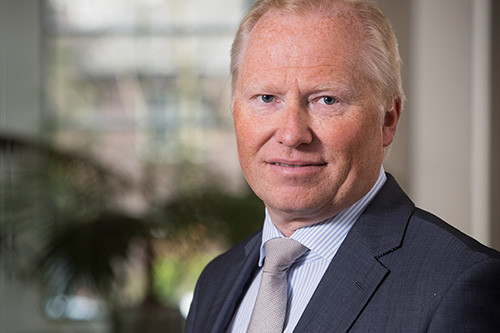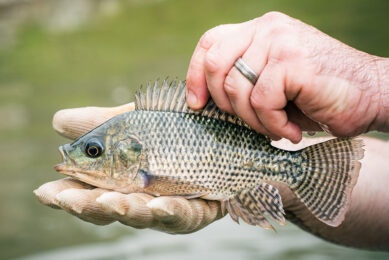Knut Nesse: “We have to restart the blue revolution”

Aquaculture is still growing, but not at the fast pace it used to. Why is that? All About Feed talked to CEO of Nutreco, Knut Nesse, about what is needed to speed up further growth in the global aquaculture industry.
Aquaculture holds the future, but at the same time is facing challenges such as pressure on the environment and the control of diseases like sea lice. This was addressed by Knut Nesse, CEO of Nutreco, at the recent AquaVision, a dedicated business event for aquaculture experts around the world. The event attracted around 450 people from 45 countries. Now held for the 12th time, and organised by Skretting, the aquafeed business of Nutreco, the need for a dedicated aquaculture conference seems more essential than ever before. Disease challenges, environmental pressure, overall reputation of the sector, use of antibiotics and the need to ‘simply’ produce more fish for a growing world population are just a few key challenges for today’s fish and shrimp farmers around the world. We started the so-called ‘blue revolution’ in the early 2000s (when the term was introduced by magazine The Economist). Nesse now says it is time to restart this revolution.
What do you mean with re-starting the blue revolution. Is aquaculture not growing fast enough?
“Since the late 90s, aquaculture has seen tremendous growth figures of 6-7% year-on-year around the world, spurred by the high demand for more animal protein. Fish is often mentioned as one of the preferred choices (as all cultures can eat it) and aquaculture is projected to supply over 60% of the total fish to consumers by 2030. However, aquaculture seems to have come to a standstill now, reflected in only a 1.4% growth over the last 5 years. The year-on-year growth in shrimp is only 1%. In salmon farming we only see moderate growth figures in the past few years. It seems that something is not working like it should. One important factor is that we lack in the ability to manage diseases properly. This is why we have to invest more in research and development in looking at new production systems, such as contained solutions. This will enable us to better control the animals and the environment.”
This means that innovation and new technologies are in high demand for aquaculture. Is this the reason why you have set up Nutreco NuFrontiers?
“Yes, certainly. Nutreco NuFrontiers is an exciting mission we started last year, spearheaded on innovation and collaboration. We focus, for example, on start-up and scale-up companies to give us better access to biotechnology and new insights and research on functional ingredients and new commodities. We also focus on new, sustainable concepts and models (game changers) and if we get granted the development licenses then we can move forward with 2 exciting pilot projects we have selected in Norway. One project is a contained solution in the Norwegian fjords (it will be the first in Norway). The innovative thing about this is that it is suitable for different fish species. The second pilot is aimed at moving salmon production from the fjords to the open ocean. If these pilot projects work, we can scale up and Norway can be, once again, an example for other countries. It is the start of a new type of fish farming. Within Nutreco NuFrontiers, collaboration is also very important. Think of the Global Salmon Initiative, SeaBOS, the Pincoy Project in Chili and the Sustainable Shrimp Partnership.”
The aquaculture industry in Norway is changing as well. What are the challenges here in the land of Salmon?
“We see that the salmon industry in Norway is also experiencing challenges in terms of growth. Since 2012, we have seen flat growth. Traditionally, many salmon farms are based in the fjords, but partly because of environmental pressure and consumer perception salmon farmers are having trouble getting licenses for further growth. So the trend is to move the farms more to the open sea. Because there are limits to how much we can still grow in Norway, Nutreco is very active in looking for growth outside the country. Over the last few years, we have increased our fish feed production sites and have now have production sites in 20 countries around the world. We see growth in Ecuador and several countries in Africa, like Nigeria. We invest where we can grow.”
And what about innovation in fish feed? What are the game changers here?
“We invest a lot in optimising our fish feed and we focus on new sustainable raw materials and new specialty ingredients. 10 years ago, it was quite normal to include 60-70% of fish meal and fish oil in fish diets. Now, we try to minimise the dependence on marine ingredients as much as possible (even to 100% in salmon) and focus more on plant-based protein sources (such as sustainable sourced soy) and new types of ingredients that are being developed. Think of insect meal or algae meal and oil for example. Another focus of ours is to develop preventive health concepts. Fish should be as strong as possible, with a healthy immune system and gut. This will help us to control and prevent disease outbreaks and hence reduce the need for antibiotics as much as possible. So gut health is a very important topic from us. We can learn from our livestock feed business Trouw Nutrition using the insights and R&D from pigs and poultry about how certain feed ingredients can have a positive effect on the intestinal health, for example. In this aspect, aquaculture is behind the conventional livestock sectors. But we are stepping up and developments are moving quicker than ever.”
You are leaving the company in an era where aquaculture is back on the agenda. Do you regret this and will you be active in the business?
“I am leaving Nutreco as of October 1st, 2018 after spending 23 years in this company. I was relatively young when I became CEO of Skretting, now 12,5 years ago. 6 years ago I became CEO of Nutreco. The reason I am stepping down is that I want to do things differently now after spending many years dedicating myself to the company. The company is very well organised and in excellent shape, so I am therefore not sad on behalf of the company. But I feel a bit sad at a personal level. It is hard to leave a company where you have spent so many years. What I will do next? I will move back to my home country Norway with my family after living in the Netherlands for many years. Norway is known for aquaculture, so don’t be surprised if I remain active in the business. Although it will be not be as an executive or CEO somewhere. I see great value in adding my skills to helping start-up companies for example. It is too early to tell right now, so we will see.”
About Skretting |











